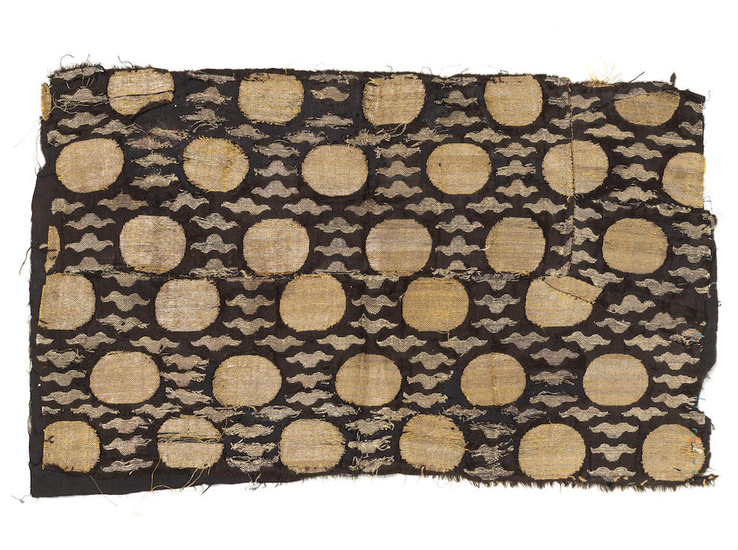A Timurid or early Ottoman silk and metal-thread brocade panel...
A Timurid or early Ottoman silk and metal-thread brocade panel
Persia or Turkey, 15th/ 16th Century
of rectangular form, woven in cream and silver thread with a repeat design of circle motifs interspersed by bubri motifs, all on a black ground, backed
37.5 x 23.5 cm.
Provenance
Private Swiss collection.
This textile panel features a distinctive combination pattern of staggered rows of circles surrounded by short wavy stripes. This pattern finds a close comparative in the famous Ottoman çintamani motif, which usually features three circles arranged in a triangle, positioned above two parallel wavy stripes. The Ottoman çintamani alludes to abstract representations of leopard spots and tiger stripes.
However, in this brocade panel, the gold brocade circles and stripes are not arranged in the standardized çintamani order. This textile could be a Timurid predecessor to the çintamani design. The Ottomans inherited the simplified circle motif from the Timurid dynasty, who were known to use the motif of three circles arranged in a triangle in coinage (Alexandru Gh.SONOC, "Some remarks on the leopard and tiger pelts in the Turko-Iranian and Indian imagery and on the origin of the chintamani motif" Brukenthal. Acta Musei, January 2022, p.468).
Timurid manuscript paintings display repeated gold-embroidered dots or circles, an adaptation of Chinese imagery, as a common motif in the representation of clothing. While there are few extant Timurid textiles, evidence from manuscripts suggests that the Timurid courtiers preferred small-scale gold brocade motifs on silk (Thomas W. Lentz and Glenn D. Lowry, Timur and the princely Vision: Persian Art and Culture in the Fifteenth Century, Los Angeles, 1989, p.217). Ruy González de Clavijo's narrative of his ambassadorial visit to Timur's court in the years 805-08/1403-06 also indicate the fashionability of gold-embroidered circles. In his description of the young Timurid prince Pir Muhammad, Clavijo notes that the prince was "sumptuously attired as is the Tartar custom, he was wearing a robe of blue [Chinese] Zaytuni silk embroidered in gold circles, like small wheels, which back and front covered his chest and shoulders and passed down the material of the sleeves" (Ruy González de Clavijo, Embassy to Tamerlane, 1403-1406, London 1928, p.254).
The tiger-stripe or bubri motif is not as commonly found as the circle motif in extant Timurid art and does not usually accompany the circle motif. However, these stripes are often seen in Timurid Shahnama manuscripts in the painted depictions of the heroic Rustam's tiger-pelt clothing.
Important Notice to Buyers
Some countries e.g., the US, prohibit or restrict the purchase by its citizens (wherever located) and/or the import of certain types of Iranian-origin works. As a convenience to buyers, Bonhams has marked with the symbol R all lots of Iranian (Persian) origin. It is each buyer's responsibility to ensure that they do not bid or import a lot in contravention of the sanctions or trade embargoes that apply to them.
View it on
Estimate
Time, Location
Auction House
A Timurid or early Ottoman silk and metal-thread brocade panel
Persia or Turkey, 15th/ 16th Century
of rectangular form, woven in cream and silver thread with a repeat design of circle motifs interspersed by bubri motifs, all on a black ground, backed
37.5 x 23.5 cm.
Provenance
Private Swiss collection.
This textile panel features a distinctive combination pattern of staggered rows of circles surrounded by short wavy stripes. This pattern finds a close comparative in the famous Ottoman çintamani motif, which usually features three circles arranged in a triangle, positioned above two parallel wavy stripes. The Ottoman çintamani alludes to abstract representations of leopard spots and tiger stripes.
However, in this brocade panel, the gold brocade circles and stripes are not arranged in the standardized çintamani order. This textile could be a Timurid predecessor to the çintamani design. The Ottomans inherited the simplified circle motif from the Timurid dynasty, who were known to use the motif of three circles arranged in a triangle in coinage (Alexandru Gh.SONOC, "Some remarks on the leopard and tiger pelts in the Turko-Iranian and Indian imagery and on the origin of the chintamani motif" Brukenthal. Acta Musei, January 2022, p.468).
Timurid manuscript paintings display repeated gold-embroidered dots or circles, an adaptation of Chinese imagery, as a common motif in the representation of clothing. While there are few extant Timurid textiles, evidence from manuscripts suggests that the Timurid courtiers preferred small-scale gold brocade motifs on silk (Thomas W. Lentz and Glenn D. Lowry, Timur and the princely Vision: Persian Art and Culture in the Fifteenth Century, Los Angeles, 1989, p.217). Ruy González de Clavijo's narrative of his ambassadorial visit to Timur's court in the years 805-08/1403-06 also indicate the fashionability of gold-embroidered circles. In his description of the young Timurid prince Pir Muhammad, Clavijo notes that the prince was "sumptuously attired as is the Tartar custom, he was wearing a robe of blue [Chinese] Zaytuni silk embroidered in gold circles, like small wheels, which back and front covered his chest and shoulders and passed down the material of the sleeves" (Ruy González de Clavijo, Embassy to Tamerlane, 1403-1406, London 1928, p.254).
The tiger-stripe or bubri motif is not as commonly found as the circle motif in extant Timurid art and does not usually accompany the circle motif. However, these stripes are often seen in Timurid Shahnama manuscripts in the painted depictions of the heroic Rustam's tiger-pelt clothing.
Important Notice to Buyers
Some countries e.g., the US, prohibit or restrict the purchase by its citizens (wherever located) and/or the import of certain types of Iranian-origin works. As a convenience to buyers, Bonhams has marked with the symbol R all lots of Iranian (Persian) origin. It is each buyer's responsibility to ensure that they do not bid or import a lot in contravention of the sanctions or trade embargoes that apply to them.



